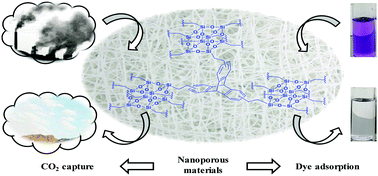Silsesquioxane-based and triptycene-linked nanoporous polymers (STNPs) with a high surface area for CO2 uptake and efficient dye removal applications†
Abstract
A unique set of polymers were conveniently obtained by marriage of ‘cubic’ octavinylsilsesquioxane (OVS) and ‘paddle wheel’ shaped triptycene using the simple and economical Friedel–Crafts reaction. The resulting ‘hybrid inorganic–organic polymers’ (STNPs) are nanoporous with higher surface areas than several previously reported porous polymeric networks containing either one of the two structural motifs (OVS or triptycene). In addition, the STNP with the highest surface area (STNP3) also has better gas storage and dye capture abilities than several organic adsorbents derived from silsesquioxanes. The performance of STNP3 as a dye adsorbent suggests that it can be further explored for environmental remediation.



 Please wait while we load your content...
Please wait while we load your content...